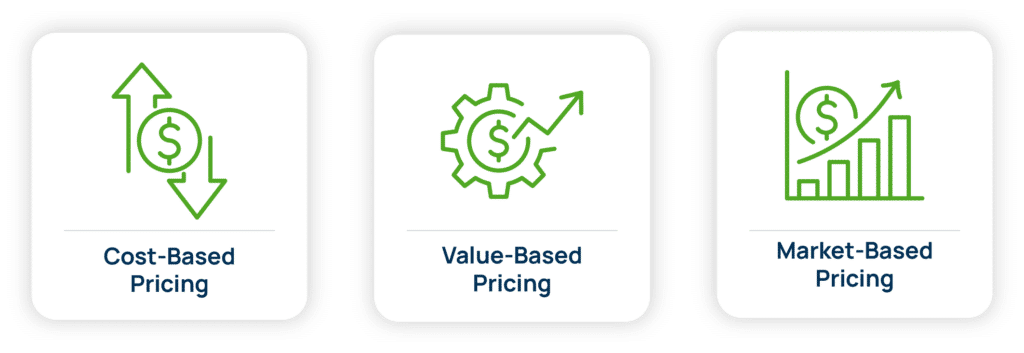
Pricing is the clearest way that companies communicate their value to the market and has the greatest impact on profit compared to any other typical variable. In this article, Dan Cakora, Business Consultant at Vendavo, explores what a B2B pricing strategy is, the different types of pricing strategies, and why the one you choose matters for your company’s bottom line.
In a renowned Harvard Business Review article, economist and business strategy expert Michael E. Porter defines strategy in a simple, yet powerful way. He says, “Competitive strategy is about being different. It means deliberately choosing a different set of activities to deliver a unique mix of value.” Put simply, strategy determines what your company will and will not do.
But differentiation without purpose lacks merit. Companies differentiate to cater to specific markets, offering unique value that surpasses production and selling costs, which should lead to profit. There is one element they must get right, though, and that’s pricing.
Pricing is the clearest way that companies communicate their value to the market. Research shows that price has more impact on profit than volume, cost, or any other typical business variable. Given its influence on profitability, a fitting pricing strategy is one of the most vital strategic decisions an executive will make.
What are B2B Pricing Strategies?
A B2B pricing strategy is an approach that dictates how a business sets and adjusts prices for its products or services when selling to their customers – other businesses. This strategy encompasses various factors including cost analysis, market conditions, competition, customer value, willingness to pay, and more.
It’s important to understand the difference between pricing strategy and pricing optimization:
- Pricing strategy – how a company positions itself in the market through pricing. A grocer may market itself as “everyday low pricing,” for example, whereas a luxury retailer may price at a premium to enhance its exclusive image.
- Pricing optimization – the collection of analytical, tactical decisions that determine prices now.
Strategy should be durable over the long term, while optimization needs to change quickly and often. Setting a sound pricing strategy requires an understanding of your company’s purpose, comparative advantage relative to competition, and necessary financial elements for sustainability.
Why Are B2B Pricing Strategies Important?
A pricing strategy is critical for any business because it directly impacts revenue, profitability, and growth.
Beyond the obvious, an effective pricing strategy will help you adapt to changing market conditions, help you foster strong, long-lasting relationships, and drive innovation and support product development, enabling expansion into new markets.
Different Types of B2B Pricing Strategies & B2B Pricing Examples

Effective pricing aims to find the right balance among costs, competitive pressures, and customer demand to optimize profitability. There are three primary B2B approaches, and each emphasizes one of these factors more than the rest. Every method has its pros and cons, but they all find support from different parts of an organization.
1. Cost-Based Pricing
Cost-based pricing, also known as “cost-plus,” is the most common approach in B2B pricing and is straightforward: determine the cost of each product, then apply a percentage increase to set the price. An item costing $50 with a desired margin of 35% is priced at $76.92, for example.
Its advantage is its simplicity. Everyone from the intern to the CEO can quickly grasp how this approach works. It seems to protect against selling below cost and avoiding losses, which the finance team certainly appreciates.
But its flaws are numerous:
- Internal vs. external factors
This approach only considers the firm’s internal economics and makes no attempt to understand competitor pricing or customer willingness to pay. Customers care about the price they pay, not your cost.
- Issues with objectivity
In practice, cost-plus is not as objective as it seems. Variations in standard cost, landed cost, intercompany cost, and the inclusion or exclusion of freight all yield different prices. This is exacerbated when companies add “holdbacks” – hidden profitability masquerading as additional cost – to the equation. This inflates the end price and creates distrust among the sales team by hiding true cost.
- Application woes
Real-world application has issues, too. When costs are going up, as they often do during times of economic upheaval, the model works well to pass through increases and keep margins whole. But things get difficult when costs fall. If a firm works diligently to reduce the unit cost of an item by 25% from $8 to $6, and the company expects a margin of 50%, the sell price goes from $16 to $12 and gross margin dollars go from $8 to $6. The company will need to sell 33% more units to break even.
Despite these issues, cost-plus is still incredibly common. A 2009 study found that more than 47% of firms frequently used cost-plus pricing. With the advent of sophisticated pricing software and an abundance of data, firms will surely find a better way to price.
2. Market-Based Pricing
The phrase “market-based pricing,” sometimes interchangeable with competitive pricing, can mean many things, depending on the context. In pricing strategy, it refers to the practice of setting prices based on competitors’ pricing. This approach is common in two scenarios:
- The first is in markets where there is a clear market leader that dictates the market reference price that all competitors follow.
- The second is in markets with heavily commoditized industries where products or services are identical. In this situation, price is frequently dictated by a formula that references publicly available data such as commodity indices.
The main appeal of this approach is that it allows companies to maintain a competitive price position relative to their rivals. This keeps prices “in the market,” which the sales team appreciates.
The market-based pricing approach is not without its drawbacks, though:
- Internal and external factors
By focusing exclusively on competition, companies may overlook internal costs and ignore customers’ willingness to pay. Ignoring these important factors can lead to unprofitable decisions that leave money on the table.
- Strict competitor benchmarking
A company solely relying on setting prices as a delta to a competitor’s price commits a significant strategic error. When taken to the extreme, basing prices entirely on competitors outsources a crucial strategic decision to external parties that don’t prioritize your company’s best interests – and is a sure recipe for failure.
Benchmarking is simple to explain, but its execution is complex. It assumes that companies can scrape competitor websites for reliable price data, but the same technology that enables mass scraping also allows companies to obfuscate their online prices from bots.
Additionally, benchmarking often captures list prices, which may not be useful in industries where post-list price negotiations are common. Here, it sets a starting point for discussion and salespeople negotiate final net prices with buyers. Net prices are generally not visible to the market and thus are not available for scraping. Companies still need a process to go from list to net, and this can’t be outsourced to competition.
Even if this data can be captured, operationalizing it is a heavy lift. Companies either need a large team to recalculate their prices based on competitor data or must invest in software to automate this process for timely repricing.
Surprisingly, market-based pricing that is based on strict benchmarking can lose touch with where the actual market price is.
If Company A benchmarks Company B, and in turn Company B benchmarks Company A, they could reference each other exclusively and become untethered from the rest of the market. If this sounds absurd, consider The Making of a Fly, where two online book sellers benchmarked each other and eventually saw the price soar to over $24 million.
Due to these complexities, strict benchmarking is precarious and should be employed with caution. Monitoring multiple competitor prices to understand an acceptable price range remains a valuable exercise, however.
3. Value-Based Pricing
Value-based pricing is the simple idea that price should mirror the value a product or solution brings to customers.
In theory, a company could charge the highest feasible price if it could accurately assess a customer’s exact valuation of a product. This results in an individual price for each individual customer’s purchases. This idealistic approach, known as “perfect price discrimination” or first-order price discrimination, faces hurdles due to subjective customer valuation, measurement complexities, and potential data limitations.
Despite these constraints, value-based pricing is still worth pursuing:
- Segmentation, which is the fundamental basis for discerning willingness to pay, does not need to be perfect to be valuable. Successful strategies involve second-degree price discrimination based on volume and third-degree discrimination reliant on customer attributes (like region, industry, or purchase channel) and product attributes (including hierarchy, lifecycle, or fast vs. slow movers).
- Appropriate segmentation must be in place to prevent arbitrage and cannibalization. For instance, reducing movie theater ticket prices for people wearing blue shirts doesn’t correspond to the value of seeing a movie. It will just encourage customers to wear blue shirts, which will write down the value of tickets across the board. Instead, segmenting movie ticket prices based on time – lower for matinees, higher for nighttime screenings – efficiently targets price-sensitive daytime movie enthusiasts while charging a higher premium for viewers who value the movie as the centerpiece of a night out.
In a recent study of pricing professionals by Copperberg and Vendavo, a value-based pricing model (weighing customer willingness to pay) was the most commonly used model. (28%)
In practice, there are a few additional constraints beyond data collection to keep in mind when pursuing a value-based strategy. The presence of alternatives via competition caps how much an individual company can charge an individual customer, for example. Similarly, product substitutes limit how much can be charged. If the economics of purchasing steak are untenable, then customers will switch to hamburgers.
How to Choose the Right B2B Pricing Strategy
Every company should clearly articulate what it wants to achieve from pricing. Most of the time, a blend of cost-based, market-based, and value-based is optimal. Using a mix will minimize the drawbacks of an individual approach and provide flexibility to align with evolving corporate goals.
Cost-based pricing works well when margins need to be protected due to supplier cost increases. The value-based approach shines when customer-focus is en vogue. When growth is the order of the day, then market-based pricing supports capturing market share.
Leveraging B2B Pricing Intelligence
For B2B sales, the key to outpacing the competition often lies in one crucial element: pricing intelligence.
Leveraging advanced pricing intelligence solutions can turn this data into a strategic asset. How? By tapping into real-time market insights and customer behavior, companies can refine their pricing strategies to not just meet, but surpass market demands, thereby gaining a competitive edge.
Imagine having the power to adjust your prices dynamically based on market shifts, customer preferences, and competitor actions. This is the potential of cutting-edge technology like AI-powered dynamic pricing software, which can unlock a wealth of insights.
Here’s how leveraging pricing intelligence for B2B companies can revolutionize their pricing strategies:
- Dynamic pricing: Dynamic pricing automatically tweaks prices as market conditions change, ensuring you remain competitive without sacrificing margins.
- Segmentation optimization: Discover high-value customer segments and tailor your pricing to meet their unique needs, boosting loyalty and sales.
- Competitive positioning: Monitor competitor pricing strategies closely. This will allow you to position your offerings effectively and capitalize on market gaps.
- Price elasticity analysis: Gain a deeper understanding of how different pricing levels affect demand, enabling more intelligent pricing decisions.
- Deal scoring: Evaluate potential deals to find the balance between profitability and customer satisfaction, ensuring long-term success.
By embracing these innovative pricing intelligence tools, B2B companies can enhance their pricing accuracy and create a more agile and responsive pricing strategy that drives growth and profitability in an ever-evolving marketplace.
Common Mistakes to Avoid in B2B Pricing
Overlooking Value: Some companies make the mistake of setting prices solely based on cost-plus models or competition, neglecting the true value their products or services bring to customers. A value-based pricing approach, considering what your customer is willing to pay based on perceived benefits, will likely result in more profits.
Ignoring Data and Analytics: Failure to leverage data and analytics is another pitfall. Remember to use data to understand customer behavior, market trends, and competitive positioning. Neglecting data-driven insights can lead to suboptimal pricing decisions.
Neglecting Dynamic Pricing: B2B markets are rarely static. Don’t miss out on revenue opportunities by failing to adjust your prices in response to changing market conditions, demand fluctuations, or customer segmentation. Dynamic pricing strategies that account for these variables can yield higher profits.
Future Trends in B2B Pricing
Variation of the three pricing strategy approaches will persist, but both tactical considerations and the application of these strategies will evolve. B2B companies should expect increased eCommerce penetration and invest accordingly. Customers expect a B2C-like experience from B2B providers, so a modern, robust, easy-to-use web presence is a baseline.
The rise of eCommerce has accelerated the pace of pricing decisions. The days of annual or quarterly price updates are gone. Companies will need to invest in systems that enable quick, accurate pricing analysis to capitalize on time-sensitive opportunities. Some may even implement systems that automatically adjust prices as underlying data updates.
And the internet has expanded the availability of data about customers. This can support further segmentation, generate cross-sell and up-sell recommendations, and ultimately allow for rapid price testing and refinement of more profitable models. Artificial intelligence (in general) and machine learning (specifically) will help companies navigate this influx of data. Complexity will transform from an obstacle to good prices to an avenue for additional profit, and analysis speed and accuracy should increase as margins of error shrink.
AI price optimization solutions have been helping B2B companies dynamically set and adjust prices for years. However, it will be interesting to see how rapid AI advancements impact the pricing function and pricing strategies as things progress faster than ever.
Remember, AI and ML should not be seen as a cure-all. Despite their power, these tools need business knowledge and human oversight to ensure that their output makes sense in the real world. Neglecting this crucial aspect could result in AI-generated output that is exactly wrong.
Frequently Asked Questions (FAQs)
Here are answers to some of the questions we hear most often:
What are the key factors influencing B2B pricing strategies?
Several critical factors come into play when devising a B2B pricing strategy. Market dynamics, competitive analysis, cost structures, customer value perception, and strategic objectives all play pivotal roles in shaping effective pricing strategies.
How can businesses optimize their B2B pricing strategies?
There are several ways to optimize your pricing strategy, and Vendavo is here to help. A few of our favorite tips include:
- Embrace data-driven insights
- Invest in and deploy pricing technology, like Vendavo Pricepoint
- Align your strategy with customer value
- Monitor and adapt to market changes
- Foster collaboration between your pricing team and other departments like sales, finance, operations, and others
What is the difference between B2B and B2C pricing strategies?
While there are similar pricing techniques and strategies used in B2B and B2C, they are vastly different beasts. B2B is far more complex involving personalized contracts, volume discounts, and complex negotiations. Whereas, B2C strategies are typically a bit more fixed and standardized. B2B strategies also often focus on long-term relationships, whereas B2C strategies aim to capture a broader consumer market with tactics like competitive pricing and promotions.
How do market conditions affect B2B pricing?
Market conditions significantly impact B2B pricing. Factors like supply and demand fluctuations, competitive dynamics, economic trends, and customer behavior influence pricing decisions. Businesses must adapt to these conditions by adjusting pricing strategies, offering discounts, or revising contract terms to remain competitive and profitable in dynamic markets.
If you would like to learn more about how you can get help with your company’s pricing strategy, reach out to Vendavo.
